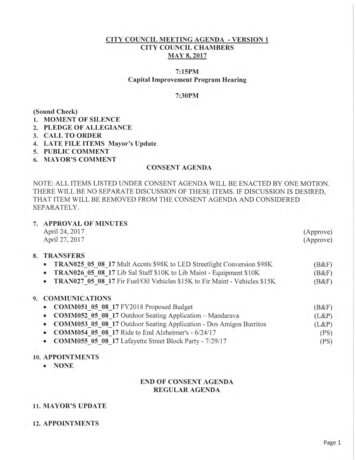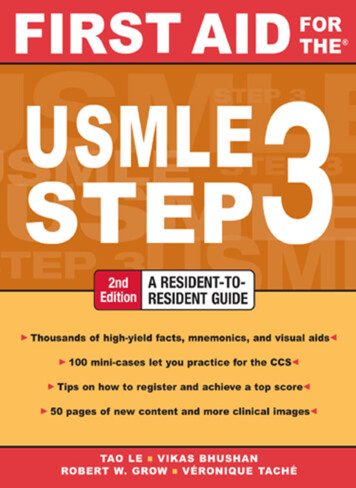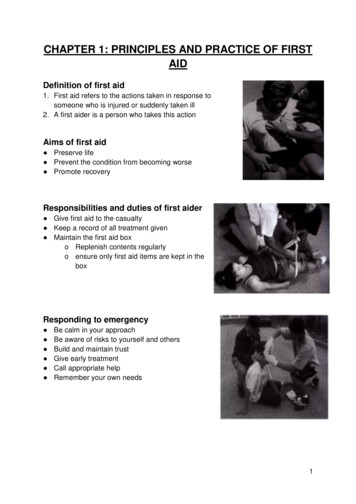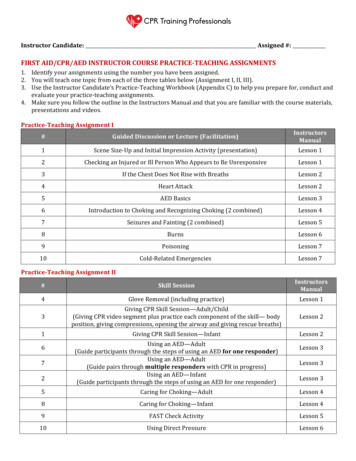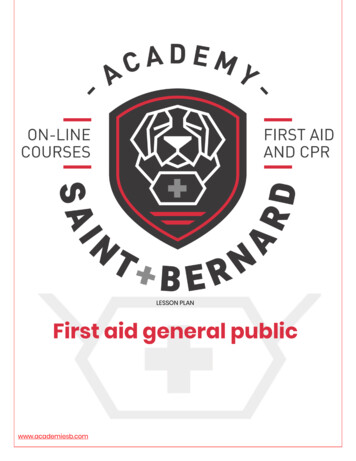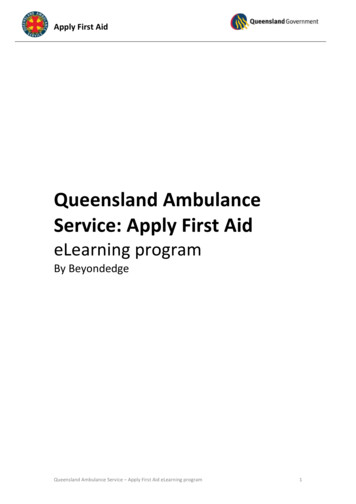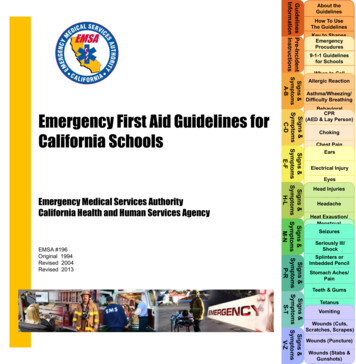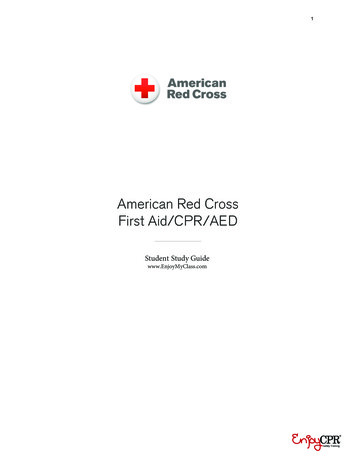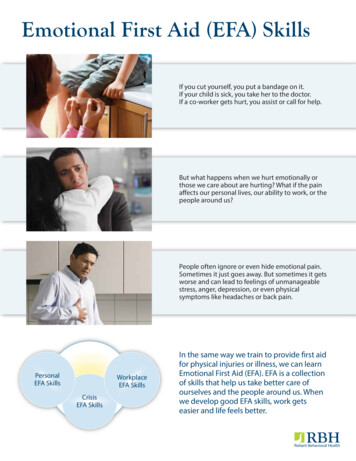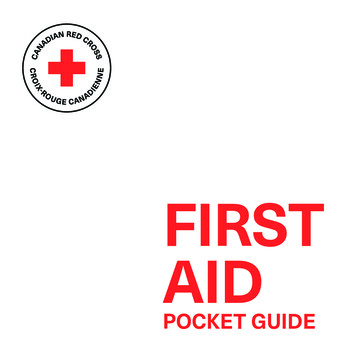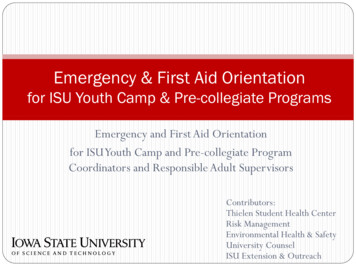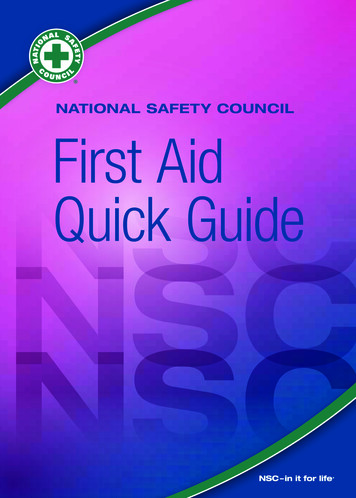
Transcription
NATIONAL SAFETY COUNCILFirst AidQuick Guide
Medical EmergencyInformationEMERGENCY TELEPHONE NUMBERS*Emergency Medical Care:Call 9-1-1 or your local numberOutside United States:Poison Control Center (United States):(800) 222-1222Local, Building or Campus-SpecificEmergency Number:Other Important Numbers:EMERGENCY EQUIPMENT*Location of nearest AED:Location of nearest first aid kit:* Be sure to check this information periodically to ensure it is current.IN ANY EMERGENCY, FOLLOW THESE 6 STEPS:1. Recognize the emergency.2. Check the scene for safety.3. Obtain consent, then check the person.4. Call 9-1-1 when appropriate.5. Care for the person.6. Have the person seek medical attention when appropriate.
NATIONAL SAFETY COUNCILFirst AidQuick Guide
Interior design, layout and composition, cover design:Envision Consulting Group, Inc.Photo Credits: Cover (Front/Back/Inside): Envision Group Consulting, Inc.;Page 1: National Safety Council/Rick Brady, photographer; Page 4: NationalSafety Council/Envision Group Consulting/October Production Post, JamiesonMulholland, photographer; Page 6 (middle right): iStockphoto/Inventori; Page 6(bottom right): iStockphoto/Inventori; Page 7: iStockphoto/RapidEye; Page 8(top): National Safety Council/Rick Brady, photographer; Page 8 (below): National Safety Council/Rick Brady, photographer; Page 13 (all 5 photos): National Safety Council/Rick Brady, photographer; Page 14 (top): NationalSafety Council/Rick Brady, photographer; Page 14 (bottom): National SafetyCouncil/Rick Brady, photographer; Page 15 (top): iStockphoto/Johnny Greig;Page 15 (bottom): Scott Camazine/Getty Images; Page 16: National SafetyCouncil/Envision Group Consulting/October Production Post, JamiesonMulholland, photographer; Page 20: National Safety Council/Rick Brady,photographer; Page 21: National Safety Council/Rick Brady, photographer;Page 22: National Safety Council/Rick Brady, photographer; Page 23 (all 4photos): National Safety Council/Rick Brady, photographer; Page 31: AnnieGriffiths Belt/Getty Images; Page 37: Image courtesy Robb S. Rehberg; Page 42: National Safety Council/Rick Brady, photographer; Page 43: iStockphoto/Jodi Jacobson; page 52: National Safety Council/Rick Brady, photographer. Allother photographs National Safety Council/Envision Group Consulting/OctoberProduction Post, Jamieson Mulholland, photographer.COPYRIGHT, WAIVER OF FIRST SALE DOCTRINENational Safety Council materials are fully protected by the United States copyrightlaws and are solely for the noncommercial, internal use of the purchaser. Withoutthe prior written consent of the National Safety Council, purchaser agrees that suchmaterials shall not be rented, leased, loaned, sold, transferred, assigned, broadcastin any media form, publicly exhibited or used outside the organization of thepurchaser, or reproduced, stored in a retrieval system, or transmitted in any form orby any means, electronic, mechanical, photocopying, recording,or otherwise.DISCLAIMERAlthough the information and recommendations containedin this publication have been compiled from sources believed to be reliable, theNational Safety Council makes no guarantee as to, and assumes no responsibilityfor, the correctness, sufficiency, or completeness of such information orrecommendations. Other or additional safety measures may be required underparticular circumstances.NATIONAL SAFETY COUNCIL MISSION STATEMENTThe National Safety Council saves lives by preventing injuries and deaths at work, inhomes and communities, and on the roads through leadership, research, educationand advocacy.nsc.org 2016 N ational Safety Counciliv National Safety Council
Welcome t o a training course of the National Safety CouncilThe nation’s leading safety advocate for more than 100 years, the NationalSafety Council is a nonprofit organization with the mission to save lives bypreventing injuries and deaths at work, in homes and communities, and on theroad through leadership, research, education and advocacy. Working to makethe world measurably safer, NSC advances this mission by engaging businesses,government agencies, elected officials and the public to help prevent the fourthleading cause of death in the U.S. – unintentional injuries. The Council is datadriven, relying on research to inform best practice solutions to safety issues.To make the greatest impact, NSC focuses on where the most preventableinjuries and deaths occur – cell phone use while driving, teen driving, workplacesafety, prescription painkiller use and safety in the community. As a catalyst forbehavior change, NSC promotes April as Distracted Driving Awareness Monthand June as National Safety Month.Acknowledged as the go-to source for safety, NSC provides a variety ofeducational opportunities – many through NSC University – including FirstAid, Workplace Safety and Driver Safety courses, and is a leading source ofoccupational safety information through Safety Health magazine. The NSCCongress & Expo brings together the world’s largest annual gathering of safetyprofessionals. Through the Safe Communities America program, NSC certifiescommunities with rigorous safety initiatives.The Campbell Institute at NSC is the global center of excellence forenvironmental, health and safety and collaborates with top performingorganizations to share research and best practices widely across industries.The Council recognizes organizations that have focused on safety as a criticalpart of their operations with the prestigious Robert W. Campbell Award .Celebrating significant safety achievements, NSC presents the Green Crossfor Safety award for safety excellence, innovation and advocacy. The highestsafety recognition for individuals is the Council’s Distinguished Service to SafetyAwards, given annually.NSC uses the concept of the Journey to Safety Excellence as a roadmapfor organizations to continuously improve their safety practice to ensure zeroharm. A 501c3 nonprofit, chartered by Congress with local Chapters and globalnetworks, and more than 50,000 members, NSC is committed to helping keeppeople safe wherever they are.First Aid Quick Guide v
Author AcknowledgementsMany National Safety Council staff and affiliates havecontributed to the production of this book, and we would liketo acknowledge the following people for their assistance:Paul Satterlee MD, forreviewing and providingoversight of content.Donna Fredenhagen,Product Manager, for providingmarketing support.Tom Lochhaas, EditorialServices, for providingtechnical writing services.David A. Middlemas, EdD,ATC, Subject Matter Expert, forassistance with technical review.Joanne Ploch, MEd, ATC,Donna M. Siegfried, SeniorSubject Matter Expert, forDirector, First Aid Programs,for providing vision and support. assistance with technical review.Robb Rehberg, PhD, ATC,NREMT, Director, ProgramDevelopment and Training, forproviding oversight of content,development and production.Michael A. Prybicien, MA,ATC, Subject Matter Expert, forassistance with technical review.Barbara Caracci, NREMTEnvision Group Consulting,Inc.The Council also recognizes with appreciation the many otherNSC employees who devoted time to this project.vi National Safety Council
Reviewer AcknowledgementsRebecca Gribben, BS, EMTInstructor/Instructor TrainerMedical Emergency ResponseTrainingHouston, TXAndrew M. LibonateOccupational Safetyand Health SpecialistChesapeake RegionSafety CouncilBaltimore, MDJ. Timothy Sensor, ATC, LATDirectorSafe Sports TrainingConsultantsScotch Plains, NJWade SkinnerEmergency ServicesCoordinatorRio Tinto KennecottSouth Jordan, UTJack WebergOwnerKeepSafePhoenix, AZTony WestendorfIowa Illinois Safety CouncilUrbandale, IAFirst Aid Quick Guide vii
Table of ContentsAbdominal Injuries – Open and Closed.1Abdominal Injury – Closed.1Abdominal Injury – Open.1Abdominal Pain.2Alcohol Overdose.3Allergic Reaction (Severe). 3Amputation.4Angina.5Asthma.5Bee or Wasp Sting.6Bite – Animal or Human.7Bleeding.7Pressure Bandage to Control Bleeding.9Tourniquet to Control Limb Bleeding.9To Use an Improvised Tourniquet.10Bleeding – Internal.10Breathing Difficulty.11Broken Bones and Dislocations.12Splinting.12Splinting an Arm.13Arm Sling and Binder.13Splinting a Leg.14Broken Ribs.14Bruises.14Burns – Heat.15First-and Second-Degree Burns.15Third-Degree Burn.16Chemical Burns.17Chest Wound - Open.17Choking – Responsive Adult or Child.18Choking – Responsive Infant.19Concussion.20viii National Safety Council
CPR.20CPR (adult, child, and infant).20CPR – Hands – Only.22CPR – Using an AED.23Crush Injuries.24Diabetic Emergencies.24Diabetes: Low Blood Sugar.24Diabetes: High Blood Sugar.25Drug Overdose.25Opioid Drug Overdose.26Ear Injuries.28Electrical Shock or Burns.28Exertional Dehydration.28Eye Injuries.29Blow to the Eye.29Chemical or Other Substance Splashed in the Eye. 29Large Object Embedded in the Eye. 30Small Particle in the Eye. 30Fainting.31Frostbite.31Genitals Injury.32Head and Face Injuries.32Cheek Wound: Impaled Object. 33Head Wound (No Skull Fracture). 33Skull Fracture. 34Heart Attack. 34Heat Cramps.35Heat Stroke or Heat Exhaustion. 36Heat Exhaustion. 36Heat Stroke.37Hip Injury.37Hypothermia. 38Impaled Object in Wound. 39Jellyfish Sting. 39First Aid Quick Guide ix
Table of ContentscontinuedMouth Injuries.40Muscle Cramp.40Muscle Strain.41Nosebleed or Injury.42Poison Ivy, Oak, Sumac. 43Poisoning – Inhaled. 43Poisoning – Swallowed. 44Pregnancy Problems. 45Vaginal Bleeding. 45Other Problems in Pregnancy. 45Puncture Wound. 45Recovery Position – Adult or Child.46Recovery Position – Infant.46Scorpion Sting.47Seizure.48Shock.48Snake Bite.49Spider Bite.50Spinal Injury.50Splinters.51Sprain.52Bandaging a Sprain.52Stroke. 53Sudden Illness. 54Tick Bite.55Tooth Knocked Out.55Wound Care.56x National Safety Council
Abdominal Injuries – Openand ClosedIMMEDIATE MEDICAL HELP IS NEEDED!Abdominal Injury – ClosedSIGNS AND SYMPTOMS:Severe pain or tenderness in area, victimprotecting the abdomen, bruising, swollenor rigid abdomen, rapid shallow breathing,nausea or vomiting.1. Carefully position the victim on his orher back. Loosen tight clothing.2. Call 9-1-1.3. Treat for Shock (p. 48), monitor the victim’sbreathing and be ready to give CPR (p. 20)if needed.Abdominal Injury – Open1. Position the victim on his or her backand loosen any tight clothing.2. Do not push protruding organs back insidethe abdomen. Cover the wound with amoist, sterile dressing or a dry,nonadherent dressing. Do not applydirect pressure on the wound.3. Cover the dressing with a large occlusivedressing or plastic wrap taped loosely inplace. Then cover the area with a blanketor towel to help maintain warmth.STEP 34. Call 9-1-1.5. Treat the victim for Shock (p. 48). Monitorthe victim’s breathing and be ready to giveCPR (p. 20) if needed.First Aid Quick Guide 1
Abdominal Pain1. Always Call 9-1-1 for an abdominalinjury (see previous page).2. Seek urgent medical attention for any severeabdominal pain in the following situations.In adults: Sudden, severe, intolerable pain or painthat causes awakening from sleep. Pain that begins in general area of centralabdomen and later moves to lower right. Pain accompanied by fever, sweating, blackor bloody stool or blood in urine. Pain in pregnancy or accompanyingabnormal vaginal bleeding. Pain accompanied by dry mouth, dizzinesson standing, or decreased urination. Pain accompanied by difficulty breathing. Pain accompanied by vomitingblood or greenish-brown fluid.In young children: Pain that occurs suddenly, stops andthen returns without warning. Pain accompanied by red or purple jellylike stool or by blood or mucus in stool. Pain accompanied bygreenish-brown vomit. Pain with a swollen abdomenthat feels hard. Pain with a hard lump in lower abdomenor groin area.2 National Safety Council
Alcohol Overdose1. Check for injuries or illness. Do notassume alcohol is the factor involved.Note that victims with uncontrolleddiabetes may seem intoxicated.2. For a responsive intoxicated person:a. Stay with the person and protect himor her from injury (take away car keys).b. Do not let the victim lie down on hisor her back.3. For an unresponsive intoxicated person:a. Put an unresponsive, breathing victim(if no evidence of trauma) in the RecoveryPosition (p. 46). Be prepared for vomiting.b. Monitor the victim’s breathing and giveCPR (p. 20) if needed.c.Call 9-1-1 if the victim’s breathingis irregular, if seizures occur or if thevictim cannot be roused (coma).d. Protect an intoxicated person fromHypothermia (p. 38).Allergic Reaction (Severe)IMMEDIATE MEDICAL HELP IS NEEDED!A severe allergic reaction is life-threatening.Common causes include certain drugs suchas penicillin, certain foods such as peanuts andshellfish, certain substances such as latex, andinsect stings and bites.SIGNS AND SYMPTOMS:Difficulty breathing, wheezing, tightness in throator chest, swelling of the face and neck, puffyeyes, anxiety or agitation, nausea, vomiting orchanging levels of responsiveness.First Aid Quick Guide 3
1. Call 9-1-1.2. Help a responsive victim use his or heremergency epinephrine auto-injector. Ifthe victim cannot use the prescribed autoinjector, you may administer it yourselfif permitted by state law. Always followthe directions on the auto-injector.3. Take the auto-injector out of its case andremove the cap or protective cover.4. To administer the medication, press the autoinjector firmly against the outer thigh and holdit there while the medication is injected (followthe product instructions for how long). Youshould feel a “click” when the injection starts.a. The medication should provide relief for15-20 minutes.b. If symptoms continue after the first doseof epinephrine has been given, and if EMSpersonnel are not expected to arrive within5-10 minutes, administer a second dose ofepinephrine, using a second auto-injector.5. Monitor the victim’s breathing and be readyto give CPR (p. 20) if needed.6. Help a responsive victim sit up in a position ofeasiest breathing. Put an unresponsive victimwho is breathing in the Recovery Position(p. 46).AmputationCall 9-1-1. Control bleeding and care for thevictim’s wound first, then recover and care foramputated part:1. Wrap the severed part in a dry steriledressing or clean cloth. Do not wash it.2. Place the part in a plastic bag and seal it.4 National Safety CouncilSTEP 4NEW PHOTONEEDED
3. Place the sealed bag in another bag orcontainer with ice. Do not let the parttouch ice directly or surround it with ice.4. Give the severed part to emergencypersonnel.AnginaThe chest pain of angina usually happensafter intense activity or exertion, is recognizedas angina by the victim, and lasts only afew minutes.1. Ask if the person has been diagnosed withangina and if the pain is like angina painexperienced in the past. If so, help the persontake his or her own medication and rest.2. If the pain persists more than 10 minutes orstops and then returns or if the victim hasother heart attack symptoms not relieved byrest, give first aid for a Heart Attack (p 34).AsthmaSIGNS AND SYMPTOMS:Wheezing and difficulty breathing and speaking,dry persistent cough, fear or anxiety, gray-blue orashen skin or changing levels of responsiveness.1. If the victim does not know he or she hasasthma (first attack), Call 9-1-1 immediately.2. If the victim identifies the breathingdifficulty as an asthma attack and has beenprescribed medication (usually an inhaler),help the victim use the prescribed inhaler asdirected by his or her health care provider. Remove the cap. Shake the inhaler several times. Connect the spacer (if needed).First Aid Quick Guide 5
The victim places the inhaler or spacerend in mouth. The victim presses the applicator downwhile slowly inhaling. Remind the victim to hold his or her breathwith the medication for about 10 seconds.3. Help the victim rest in a position foreasiest breathing (usually sitting up).4. If needed, the victim may use the prescribedinhaler again as directed by his or her healthcare provider. If the breathing difficultypersists after use of the inhaler, Call 9-1-1.Back InjurySee Spinal Injury (p. 50).Bee or Wasp Sting1. Remove stinger from skin by scraping itaway gently with a piece of plastic, such asa credit card (not a knife blade). Call 9-1-1if the victim has a known allergy to stings.2. Wash the area with soap and water.3. Put ice or a cold pack on the sting site forup to 20 minutes (with a cloth or paper towelbetween the cold pack and the skin). Applythe cold for 20 minutes (or 10 minutes if itproduces discomfort), then remove it for30 minutes; reapply for 20 (or 10) minutes,then remove again for 30 minutes.4. Watch the victim for 30 minutes for anysigns or symptoms of severe allergic reaction(difficulty breathing, swelling in other areas,anxiety, nausea or vomiting); Call 9-1-1and treat the Allergic Reaction (p. 3).5. Allow the victim to use an over-the-counteroral antihistamine to help reduce discomfort.6 National Safety CouncilSTEP 1SUGGESTEDIMAGESTOCK PHOTOID:66951037STEP 5SUGGESTEDIMAGESTOCK PHOTOID:10126805
6. Have the victim suck on ice for aninsect sting in the mouth.7. Do not allow the victim to scratchthe sting, as this increases swelling,itching and the risk for infection.Bite – Animal or Human1. Clean the wound with large amountsof warm or room-temperature water withor without soap.ANIMAL BITE2. Control Bleeding (p. 7).3. Cover the wound with a steriledressing and bandage.4. Seek medical attention immediately.5. Do not try to catch the animal, butnote its appearance and describeit to the health care provider.BitesSee Snake Bite (p. 49) and Spider Bite (p. 50)BleedingIf severe bleeding is occurring, shout forsomeone to Call 9-1-1.1. Put on medical exam gloves or keepa barrier (dressing, plastic bag)between you and the blood.2. Put a sterile dressing or cleancloth on the wound.3. Push on the wound with your gloved handas hard as needed for about 5 minutes.First Aid Quick Guide 7
4. Reevaluate the bleeding.STEP 4a. If direct pressure does not control thebleeding and you have a hemostaticdressing, remove dressings already usedand apply the hemostatic dressing directlyon the wound using direct pressure.b. If a hemostatic dressing is not available,continue to apply direct pressure. If bloodsoaks through the first dressing, putanother dressing or cloth pad on top ofthe first and keep applying pressure.5. If needed, apply a pressure bandage to keeppressure on the wound, wrapping from theend of the extremity toward the center of thebody – see Pressure Bandage on next page.Use a tourniquet (if you are so trained)when direct pressure does not controlsevere bleeding from a limb.6. If severe bleeding is occurring, treatthe victim for Shock (p. 48).7. See a health care provider immediately for: Bleeding not easily controlled. Deep or large wounds. Significant face wounds. Possible wound infection. Animal or Human Bite (p. 7). Object in the wound. Tetanus vaccination if needed. Wounds that may need stitches.8. Minor wounds may be cleaned, dressedand bandaged – see Wound Care (p. 56).8 National Safety CouncilSTEP 5
Pressure Bandage toControl Bleeding1. Place sterile dressing or clean cloth on wound.Start wrapping an elastic or self-adheringroller bandage below the wound dressing.2. Make several circular turns, then overlapturns, by about half of previous turn.3. Work up the limb to cover the dressingcompletely. The pressure is sufficientif the bandage is snug but a finger canbe slipped under it.4. Secure the bandage by tying it in placeor with clips or tape.Tourniquet to ControlLimb BleedingA tourniquet can be used when you are unableto control bleeding in a limb with standardbleeding control (direct pressure with or withouta dressing). Examples when a tourniquet maybe appropriate: There are multiple victims to care for. The victim has multiple injuries requiring care. The environment is unsafe and you needto evacuate the victim. You are unable to access the wound.Note: Use a commercial tourniquet if available,following the manufacturer’s steps for its correctuse. Only apply a tourniquet if you are trained.First Aid Quick Guide 9
To Use an Improvised Tourniquet1. To make a tourniquet, use a nonstretchy material, such as terry clothor a triangular bandage), foldedlengthwise to be 1-2 inches wide.2. Tie the tourniquet around the injured armor leg, several inches above the injury. Ifthe injury is below the elbow or knee, youmay need to tie the tourniquet above thejoint. Use a common square knot (liketying your shoes without the bow).3. Above the first knot in the tourniquet,position a stick or other long object as awindlass that can be twisted to tighten thetourniquet, and tie a second square knot.Use any long object that is strong enoughto hold the tourniquet and can be securedin place (a pencil, stick, spoon, pipe, etc.).4. Twist the windlass to increase thepressure until the bleeding stops.5. Secure the windlass in place by tying oneor both ends to the victim’s arm or leg.6. If possible, mark the time the tourniquetwas placed by putting a “T” on thevictim’s forehead with the time/day.Bleeding – InternalSIGNS AND SYMPTOMS:Of severe internal bleeding: tender, swollen,bruised or hard abdomen; blood vomited orcoughed up or present in urine; cool, clammyskin that may be pale or bluish; thirst; confusion;or lightheadedness.1. Have the victim lie down on his or her back.2. Call 9-1-1.10 National Safety Council
3. Be alert for vomiting. Put a breathing victimwho vomits or who becomes unresponsive(if no suspected trauma, especiallya neck, back, hip or pelvic injury) inthe Recovery Position (p. 46).4. Keep the victim from becomingchilled or overheated.5. Do not give the victim anything to drink.6. If the victim becomes unresponsive,monitor his or her breathing and beready to give CPR (p. 20) if needed.For less serious internal bleeding, such asbruising in the arm or leg, apply cold to the area.Place a plastic bag or damp cloth with an icewater mix on the injured area to reduce swellingand pain; put a barrier, such as a cloth, betweenthe plastic bag and the skin. A cold pack alsocan be used. Apply the cold for 20 minutes(or 10 minutes if it produces discomfort), thenremove it for 30 minutes; reapply for 20 (or 10)minutes, then remove again for 30 minutes.See also Abdominal Injury — Closed (p. 1).Breathing DifficultyIMMEDIATE MEDICAL HELP IS NEEDED!SIGNS AND SYMPTOMS:Gasping or unable to catch one’s breath, speakingin shortened sentences, very fast or very slowbreathing, very deep or shallow breathing,wheezing or gurgling with breathing, dizzinessor lightheadedness, or pale or ashen skin.1. Call 9-1-1 for sudden unexplainedbreathing problems.2. Help the victim rest in a position of easiestbreathing. Calm and reassure the victim.3. If the victim is hyperventilating, ask him orher to breathe slowly.First Aid Quick Guide 11
4. Ask the victim about any prescribedmedicine he or she may have andhelp the victim take it if needed.5. Stay with the victim and be preparedto give CPR (p. 20) if breathing stops.Broken Bones andDislocationsCall 9-1-1 for a large bone fracture or anydislocation (except in the hand or finger).
First Aid Quick Guide Printed in the U.S.A. Product Number 79130-0024 1121 Spring Lake Drive Itasca, IL 60143-3201 (800) 621-7619 nsc.org Each year in the United States, more than 300,000 people suffer sudden cardiac arrest. In most communities fewer than
